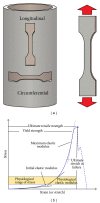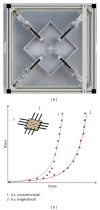Biomechanical evaluation of ascending aortic aneurysms
- PMID: 24991568
- PMCID: PMC4065659
- DOI: 10.1155/2014/820385
Biomechanical evaluation of ascending aortic aneurysms
Abstract
The biomechanical properties of ascending aortic aneurysms were investigated only in the last decade in a limited number of studies. Indeed, in recent years, there has been a growing interest in this field in order to identify new predictive parameters of risk of dissection, which may have clinical relevance. The researches performed so far have been conducted according to the methods used in the study of abdominal aortic aneurysms. In most cases, uniaxial or biaxial tensile tests were used, while in a smaller number of studies other methods, such as opening angle, bulge inflation, and inflation-extension tests, were used. However, parameters and protocols of these tests are at present very heterogeneous in the studies reported in the literature, and, therefore, the results are not comparable and are sometimes conflicting. The purpose of this review then thence to provide a comprehensive analysis of the experimental methodology for determination of biomechanical properties in the specific field of aneurysms of the ascending aorta to allow for better comparison and understanding of the results.
Figures
References
-
- Hiratzka LF, Bakris GL, Beckman JA, et al. ACCF/AHA/AATS/ACR/ASA/SCA/SCAI/SIR/STS/SVM Guidelines for the diagnosis and management of patients with thoracic aortic disease: a report of the American College of Cardiology Foundation/American Heart Association Task Force on Practice Guidelines, American Association for Thoracic Surgery, American College of Radiology, American Stroke Association, Society of Cardiovascular Anesthesiologists, Society for Cardiovascular Angiography and Interventions, Society of Interventional Radiology, Society of Thoracic Surgeons, and Society for Vascular Medicine. Circulation. 2010;121:e266–e369. - PubMed
-
- Pape LA, Tsai TT, International Registry of Acute Aortic Dissection (IRAD) Investigators, et al. Aortic diameter ≥5.5 cm is not a good predictor of type A aortic dissection: observations from the International Registry of Acute Aortic Dissection (IRAD) Circulation. 2007;116(10):1120–1127. - PubMed
-
- Okamoto RJ, Wagenseil JE, DeLong WR, Peterson SJ, Kouchoukos NT, Sundt TM., III Mechanical properties of dilated human ascending aorta. Annals of Biomedical Engineering. 2002;30(5):624–635. - PubMed
-
- Okamoto RJ, Xu H, Kouchoukos NT, Moon MR, Sundt TM., III The influence of mechanical properties on wall stress and distensibility of the dilated ascending aorta. Journal of Thoracic and Cardiovascular Surgery. 2003;126(3):842–850. - PubMed
-
- Vorp DA, Schiro BJ, Ehrlich MP, Juvonen TS, Ergin MA, Griffith BP. Effect of aneurysm on the tensile strength and biomechanical behavior of the ascending thoracic aorta. Annals of Thoracic Surgery. 2003;75(4):1210–1214. - PubMed
Publication types
MeSH terms
LinkOut - more resources
Full Text Sources
Other Literature Sources
Medical



